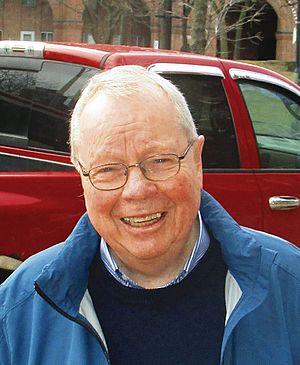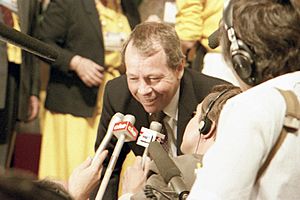David Crombie facts for kids
Quick facts for kids
David Crombie
|
|
|---|---|

David Crombie, 2016
|
|
| 56th Mayor of Toronto | |
| In office December 1, 1972 – August 31, 1978 |
|
| Preceded by | William Dennison |
| Succeeded by | Fred Beavis (Interim) |
| Member of Parliament for Rosedale |
|
| In office August 31, 1978 – October 1, 1988 |
|
| Preceded by | Donald Stovel Macdonald |
| Succeeded by | David MacDonald |
| Minister of National Health and Welfare | |
| In office June 4, 1979 – March 2, 1980 |
|
| Prime Minister | Joe Clark |
| Preceded by | Monique Bégin |
| Succeeded by | Monique Bégin |
| Minister of Indian Affairs and Northern Development | |
| In office September 17, 1984 – June 29, 1986 |
|
| Prime Minister | Brian Mulroney |
| Preceded by | Doug Frith |
| Succeeded by | Bill McKnight |
| Secretary of State for Canada and Minister responsible for Multiculturalism | |
| In office June 30, 1986 – March 30, 1988 |
|
| Prime Minister | Brian Mulroney |
| Preceded by | Benoît Bouchard |
| Succeeded by | Lucien Bouchard |
| Other offices | |
| 1969–1972 | Toronto Alderman |
| Personal details | |
| Born |
David Edward Crombie
April 24, 1936 Swansea, Ontario, Canada |
| Political party | Progressive Conservative |
| Spouse | Shirley Ann (Bowden) Crombie |
| Children | Jonathan, Robin, Carrie |
| Occupation |
|
David Edward Crombie (born April 24, 1936) is a Canadian professor and politician. He was the 56th Mayor of Toronto from 1972 to 1978. After being mayor, Crombie was elected to the Canadian Parliament. He was a member of the Progressive Conservative (PC) Party. He also served as a minister in the Canadian government, holding important roles like Minister of Health and Welfare.
Contents
Early Life and Community Work
David Crombie was born in Swansea, a village that is now part of Toronto, Ontario. In the 1960s, he taught politics and city planning at Ryerson. During this time, he became involved in a movement to improve Toronto's urban areas.
At that time, Toronto's city council often approved plans to tear down old buildings and homes. They wanted to build new apartment buildings, offices, and highways. Crombie and other reformers, like John Sewell, led a group of people who wanted to protect older buildings. They also wanted to improve community services and focus on what local residents needed.
Becoming Mayor of Toronto
Crombie was elected to Toronto's city council in 1970. In 1972, he became the Mayor of Toronto. He brought a new way of thinking about city development, inspired by ideas from urban planners like Jane Jacobs. Crombie was the first mayor from this "reform movement" in Toronto politics. His ideas were very different from the mayors who came before him.
Protecting Toronto's Waterfront
As mayor, David Crombie worked hard to control new building projects. He first tried to limit new buildings to 45 feet (about 13.7 meters) tall. However, this rule was changed by the Ontario Municipal Board. Crombie then created a new city plan that set different height limits for different areas of the city. This plan was approved.
Crombie also helped stop the construction of the Scarborough Expressway. All work on this highway stopped during his time as mayor, and it was eventually cancelled. He also opposed tearing down older, poorer neighborhoods to build large housing projects. Plans to rebuild areas like Trefann Court, Kensington Market, and Cabbagetown ended under Crombie's leadership.
Instead, he helped create the St. Lawrence neighborhood. This area has mid-rise buildings with different types of homes and businesses. It was designed to follow Jane Jacobs's ideas for diverse and lively city spaces.
Crombie was very popular and was re-elected as mayor in 1974 and 1976. Because of his popularity and his height, people often called him the city's "tiny, perfect mayor."
National Politics
In 1978, David Crombie left his role as mayor to enter national politics. He won a special election and became a member of the House of Commons of Canada. He was part of the Progressive Conservative Party.
Crombie served as the Minister of Health and Welfare from 1979 to 1980. This was during the short time that Joe Clark was Prime Minister. Later, when Brian Mulroney became Prime Minister in 1984, Crombie served as Minister of Indian and Northern Affairs. He also became the Secretary of State and Minister of Multiculturalism.
Royal Commission on the Future of the Toronto Waterfront
David Crombie decided not to run for re-election in 1988. He returned to working on city issues. He became the head of a special group called the Royal Commission on the Future of Toronto's Waterfront (1988–1992).
He wrote important reports like Watershed and Regeneration. These reports suggested new ways to plan cities that are good for the environment and communities. The government then asked Crombie to lead an agency called the Waterfront Regeneration Trust Agency (1992-1999). This agency worked to put his ideas into action.
One of the big ideas was to create a waterfront trail. Today, the Great Lakes Waterfront Trail stretches from Quebec to Sault Ste Marie, along Canada's Great Lakes and the St. Lawrence River. In 1999, Crombie started the Waterfront Regeneration Trust, which is a charity. This charity continues to work on the trail and helps protect and restore the Rouge Valley, which is now part of the Rouge National Urban Park.
Improving Health Services for Indigenous Peoples
In 1979, when David Crombie was Minister of Health and Welfare, he made an important statement. He said that the Canadian government wanted to work with Indigenous leaders to review health services for Indigenous communities. This was a big step towards giving Indigenous groups more control over their own health care.
Before this, Indigenous groups had been asking for more control over health services in their communities. They also wanted help with environmental health problems. Crombie appointed Gary Goldthorpe to investigate concerns about health care delivery in British Columbia.
Later, Justice Thomas Berger recommended that the government talk more with Indigenous and Inuit peoples about health programs. He also suggested providing money to help Indigenous communities develop their own health consultation groups. Crombie's successor, Monique Begin, followed these recommendations. This marked the beginning of a change in how health services were provided to Indigenous peoples.
Later Career and Recognition
In 1994, David Crombie became the first chancellor of Ryerson University (now Toronto Metropolitan University). He held this role until 1999.
Throughout the 1990s, he advised city and provincial governments on urban issues in the Toronto area. He retired as CEO of the Canadian Urban Institute in 2007. In 2014, he spoke out against plans to make the runways longer at Billy Bishop Toronto City Airport on the Toronto Islands.
On May 13, 2004, Crombie was given the Order of Canada, which is one of Canada's highest honors. In 2012, he became a member of the Order of Ontario. In 2013, he was recognized in the Canadian Disability Hall of Fame.
A park in Toronto is named after him. It is located in an area that used to be industrial but was changed into housing.
Personal Life
David Crombie has two daughters, Robin and Carrie. His son, Jonathan Crombie, was an actor who starred in the Anne of Green Gables TV series. Jonathan passed away in 2015 at the age of 48.


